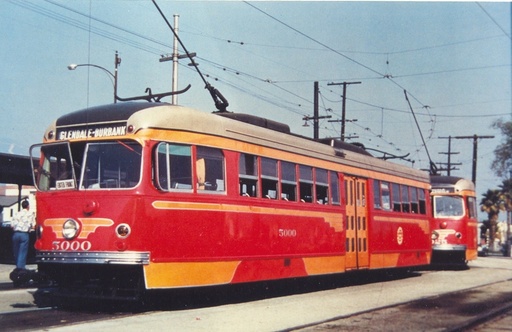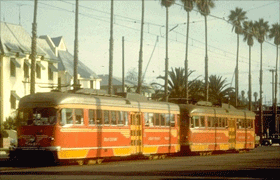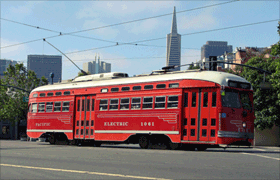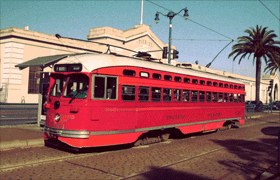
PE Car No. 5000 poses in sunlight, wearing a post-World War II version of its livery, with the original silver roof replaced by tan and the “Pacific Electric” lettering replaced by a logo.
This is the third in a series of posts concerning which historic paint schemes, or “liveries,” should be applied to three of the double-ended “torpedo” PCC streetcars about to be restored by Muni. (They’ve asked Market Street Railway for input, as their non-profit preservation partner, but the final decision is theirs.)
We’re taking a look at the different possibilities being considered, with our first focus on cities that actually ran double-end PCCs at one time. We’ve already looked at Dallas, Texas and Boston, Massachusetts. Now we look at Pacific Electric.
Of all the discussions about streetcar liveries involving Muni’s PCC fleet, none has been as intense as the one over the iconic Pacific Electric livery. This legendary system once served much of Southern California, from San Bernardino to Santa Monica. PCCs, though, were a tiny part of its fleet (just 30 cars) and, during their P-E service, from 1940 to 1955, were used primarily on just one line, from downtown LA to Burbank and Glendale (though for a brief period they also served Venice and Hollywood).
Pacific Electric was mainly what was called an “interurban” system. Interurban lines were typically longer distance than normal streetcar lines with larger, heavier duty vehicles. In many ways it was like modern light-rail, Pacific Electric even had two-car trains like Muni Metro today. This was complemented by a separate narrow-gauge local streetcar system owned first by Los Angeles Railways, later by National City Lines, and finally, by the then-regional transit agency. Two different eras of that narrow-gauge LA system are represented in Muni’s fleet by single end PCC car No. 1052 and car No. 1080.

The “wings” motif flowed from front to back from the passenger side, but from the other side, as here, they appeared to be going backward. Joe Testagroce collection.
Pacific Electric was owned by Southern Pacific Railroad, which favored at the time a striking red, orange and silver paint scheme on its “Daylight” train service between LA and San Francisco. This striking scheme also graced most Pacific Electric streetcars, none as strikingly as the streamlined PCCs, on which the Art Deco “wings” looked right at home on the car ends and sides.
P-E’s PCCs were double-ended, like four of the PCCs Muni is now restoring for F-line (and future E-line) service. But unlike any other double-ended PCCs in America, they featured doors at one end and at the center of the car, just like typical single-end PCCs. So when it came time to choose the liveries for Muni’s first batch of F-line PCCs in the 1990s, there was a conundrum.

Muni’s Pacific Electric “tribute livery,” viewed from the door side. Richard Panse photo.
If the Pacific Electric livery was applied to a single-end car, it would look “right” (i.e. more like the original) on the side of the car with the doors. On the other, “blind” side (with no doors), not so much. Yet on a double-end Muni car, it wouldn’t look accurate on either side, because the Muni double-enders have the doors at either end, none in the center. The first time around, Muni chose the single-end option and painted PCC No. 1061 to honor Pacific Electric.

Muni’s Pacific Electric “tribute livery,” viewed from the blind side. Steve Ferrario photo.
This hasn’t stopped the debate, though. Each side has its partisans. What is beyond debate is that as currently painted, No. 1061 is one of the most striking cars in the F-line fleet, based on the photos of 1061 submitted to our Flickr group and the cars chosen for use in professional photo and video shoots, as well as those images used by Muni itself to promote the F-line.
So we ask which of these options you prefer: should one of the double-end PCCs be painted in the Pacific Electric scheme? If so, should car No. 1061 be repainted, or should we have two of this striking design?
Make your opinion known below, or to comment privately, email comments@streetcar.org.
Part 1: Dallas, Texas
Part 2: Boston, Massachusetts
Part 3: Pacific Electric
Part 4: San Francisco
Part 5: Something Completely Different
In the photos, of the P-E cars in LA, the red looks more like orange but, it just maybe the age of the photo or the way the sun is hiting the car. I like the “Wings” motif if it were painted in the colors of the SP Daylight train. In my opinion, that is one of the most beautiful trains I have ever seen. If you paint one of the double-enders in the same colors as #1061, then I suggest you repaint 1061. Maybe into the MUNI “Landor” scheme. Or maybe not!!
Even though I like the look of 1061 (although not its recent performances, as an operator) and am a native Angeleno, I don’t think any city other than San Francisco should be represented by more than one car in the same livery, unless there is a significant evolution in that livery–more even than that evinced between Muni Wings 1050 and Wings-simplified 1051. I would consider flip-flopping the two versions of the PE livery on 1061 each time it comes up for a complete paint job, rather than doing a second car, especially if the double ender would make the livery look less authentic. Besides, isn’t there a green PE, or LA independent livery that we don’t yet have?
This is probably not yet the right arena to make this argument, but given each tribute car represents a fleet, somewhere else, San Francisco should be represented by an actual, tiny fleet of all its liveries, with duplicates–such that we see different cars, from Iron Monsters to PCCs in variations of the liveries they wore. But I’ll wait until we get to that part of this discussion.
O yes please,repaint 1061,and have a double end with Pacific Electric scheme,thanks..
No. Keep 1061 as it is. The right side rendition is historically accurate.
I well remember the PE double-end PCCs in active service. From 1946 to 1951 I lived a half-block from the Hollywood Boulevard Line, which saw PCC service just once a year, on New Year’s Day. They replaced the much higher capacity 5050 series which normally served Hollywood but were switched to the Pasadena Line to carry the huge crowds attending the Tournament of Roses Parade and the Rose Bowl game. My vote is to paint a double-ender in PE livery in addition to, not instead of, No. 1061.
I don’t think a torpedo should be painted into P.E.
Without the side door, it wouldn’t look right.
PE did have cars with a similar door arrangement to Muni “Torpedoes”: cars 100-114, which were standard streetcars built in 1930. Like all PE cars, they were double-ended, and like Muni 1006-1015, they had doors at each corner. In the 1940’s they were given a version of the “Daylight” inspired paint job. Since they were smaller than the PCC’s and Hollywood cars, they had one long stripe and two (rather than three) short stripes. Also, they did not get the “butterfly” stripes on the ends. At the risk of getting a bit too detailed, if this scheme were chosen, I would put it on Muni 1011, as a tribute to PE 111.
I have mixed feelings on this. I’d like to see a few more Muni wings around town, but this is a much nicer scheme, and would gladly have two PE cars around. I am mostly interested in seeing the PE scheme rendered more accurately. Would the Milano orange be a better match for the Daylight orange?
It is a very striking livery and certainly the best of the Red liveries seen so far. But I would prefer for 1061 to keep the livery. However if duplicates are allowed and San Francisco liveries should come first with this, then I wouldn’t mind seeing a second P-E Car.
Just for the record, no actual PE PCC cars survived. All 30 were sold to FC General Urquiza in Argentina (same company that bought the PE 1100-class and 732-759 cars that I rode as a boy) where they were modified for third-rail operation and had train doors cut in. They didn’t last long, being scrapped in the 1960’s.
Re: questions about the orange on the P-E scheme. When Muni first agreed to paint the PCCs, they agreed on a limited palette of colors; I think the number was 8 in total. This was done internally at Muni back in the early 1990s. Since then, through our advocacy, additional colors have been added. And of course, the Milan orange trams were added to the fleet in the late 1990s. It does appear a Milan orange would be closer to the PE scheme than the red-orange on 1061 (same would be true for Boston 1059). We are taking notes on this and want to work with Muni as time and resources allow during subsequent renovations of cars to tweak some of the original liveries to come closer to authentic colors.